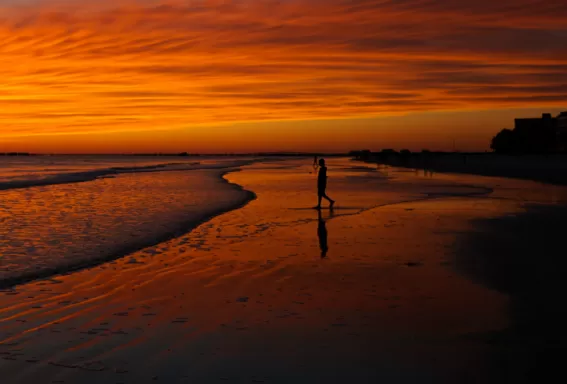Media Kit
Fast Facts
For 15 miles, Fort Myers’ McGregor Boulevard is lined on both sides with statuesque royal palm trees, the first 200 of which were imported from Cuba and planted by Thomas Edison.
The first tourist to visit Southwest Florida was Spanish explorer Ponce de Leon, who visited Pine Island in 1513 and was later mortally wounded in these same waters by a Calusa Indian arrow.
Family Fun magazine announced its travel awards, the result of polling 2,000 American families to rate their favorite destinations across five categories. The top overall winner was Sanibel, Florida, an island town with ample white beaches and seashells, and the power to chill out even the most high-strung parents and kids. The magazine reports one Texas mom as saying, “It’s just a relaxing place that lets kids be kids.”
The sport of tarpon fishing originated in Southwest Florida’s Pine Island Sound in the late 1880s, and Boca Grande Pass, the opening between Cayo Costa and Gasparilla Island, is considered the “Tarpon Fishing Capital of the World.”
Thomas Edison, who spent many winters in Fort Myers, is considered the most inventive man who ever lived, holding 1,093 patents for everything from light bulbs, cement and phonographs to the natural rubber he made from goldenrod.
Lee County area beaches are ranked some of the best in the nation for shelling, with more varieties found here than anywhere else in North America. The shelling posture are so common; they are given names – the Sanibel Stoop and the Captiva Crouch.
You can boat straight across the state of Florida from Fort Myers/Sanibel to Palm Beach via the Caloosahatchee River and Okeechobee Waterway, both part of the Intracoastal Waterway.
The banyan tree at the Edison Winter Home, a gift from industrialist Harvey Firestone, is the largest specimen in the United States. The tree’s aerial roots now have a circumference of more than 400 feet!
Koreshan State Park in Bonita Springs commemorates an eccentric religious sect, which believed the world to be a hollow globe, with mankind residing on the inner surface, gazing into the universe below.
Anne Morrow Lindbergh, the wife of America’s famous aviator, wrote her best-selling book, “A Gift From the Sea,” without ever identifying it as Captiva Island.
Legend has it that Spanish pirate Jose Gaspar made his home in Pine Island Sound, reportedly establishing headquarters on Sanibel Island, holding his female prisoners captive on Captiva Island, burying his booty on Gasparilla Island, and imprisoning his beloved Mexican Princess Joseffa on Useppa Island. Rather than be taken prisoner by the U.S. Navy, the scoundrel drowned himself in anchor chains in 1821, the same year Spain sold Florida to the U.S. government for $13 million.
Cape Coral has more canals than the Italian city of Venice.
J.N. “Ding” Darling National Wildlife Refuge, occupying more than half of Sanibel Island, was named for Pulitzer Prize-winning cartoonist Jay Norwood Darling, who was also the first environmentalist to hold a presidential cabinet post (in Franklin Delano Roosevelt’s administration).
Some of the original settlers to the Lee County area were flower growers from the Benelux region of Europe. At one time their horticultural efforts made Fort Myers the “Gladiolus Capital of the World.”
Fort Myers is one of the few places in the world where a person can make a living as a shelling charter captain. Among the rare shells collected here are the brown speckled junonia, sculpted lion’s paw, coveted golden olive, golden tulip and Scotch bonnet. Lee County has banned live shelling and encourages shell seekers to pick up treasures that have washed up on shore.
One of the southernmost land battles of the American Civil War was fought in Fort Myers on Feb. 20, 1865 over cattle, with both sides claiming victory.
Calusa Indian culture, carbon dated to 1150 B.C., had its cultural center in Southwest Florida. Although the tribe is now extinct, ceremonial, burial and refuse shell mounds are found at Mound Key, Pine Island, Cabbage Key, Useppa Island and elsewhere in the vicinity.
Since 1937, the Sanibel Shell Show has highlighted the art and beauty of shelling.
Cayo Pelau is said to be haunted by the ghosts of Jose Gaspar’s pirates who, legend has it, buried their personal wealth here and linger to prevent treasure hunters from disturbing their plunder.
Fort Myers is widely recognized and consistently ranked as one of the nation’s top destinations for beach combing, shelling, kayaking and bird watching.
The walls of Cabbage Key’s historic inn are papered in more than $70,000 autographed dollar bills. About $10,000 a year falls off, which goes to charity. The inn, built by playwright Mary Roberts Rinehart and her son in 1938, serves breakfast, lunch and dinner to guests and boaters at Mile marker 60 on the Intracoastal Waterway.
Fort Myers’ McCollum Hall, built in 1938, was a renowned “dance hall” that featured nationally famous African-American performers like Duke Ellington, Count Basie, Louis Armstrong and B.B. King.
For more information about this unspoiled island sanctuary, visit our Web site: www.FortMyersSanibel.com.

